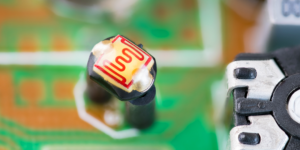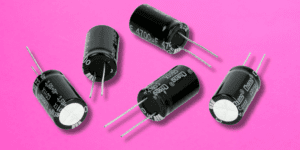Spis treści:
Man among tools, man among machines
Since the dawn of time and the beginning of his conscious existence, man has been influencing the environment in order to facilitate his own and his offspring’s survival. With time, he began to create various technical devices to increase the effectiveness of this influence. When we took a stick or a bone in our hand – although we probably first bashed our neighbour’s head in with it, rather than thinking of making a hoe or a musical instrument – and used it for a technical purpose, just as we use a hammer as a tool today, that is when human engineering began.

According to the PWN Polish language dictionary, engineering is the design and construction of objects and technical devices. Designing sounds clever, but isn’t it simply thinking things through in order to finally give the project a specific shape? The first australopithecine tools from 3.3 million years ago are the first step on the road to robotics!
What is robotics?
Robotics (robotic technology) deals with the generation of computer-controlled movements of physical objects in many different situations. Since physical objects define spatial distributions in three-dimensional space, geometric representations and computation play an important role in robotics. As a result, the field is a significant source of practical problems in the field for computational geometry.
But wait a minute! Is it good for something to be a source of problems? Yes, for science by all means. For what else is science but an attempt to answer all possible questions and to bring us with its hypothetical constructs closer to the essence of things? The problems of scientists and constructors rejoice, because without them there are no solutions.
Let’s put it even more simply: robotics is the science and technology of designing, building and using computer-controlled mechanical devices called robots (and lately, a.e., cobots and many more). It is useful in all the places where we need reliability, speed, accuracy and durability. If we don’t keep notes on methodology and taxonomy, this should actually be enough for us.
Trends and future of robotics
This is actually an area for a another discussion. The rapid development of robotic applications in numerous spheres of human life does not make things any easier. Numerous technical and social factors continue to have a significant impact on computing and, by extension, on robotics. For example, computing power per watt of electricity is increasing. In everyday life, this means that a smartphone can do more with the same battery life – yes, the charged phone battery cycle of the now-ancient but still loved for its sturdiness Nokia 3510 was over 300 hours, but the capabilities of mobile phones have grown unimaginably in those 20 years. It also means faster progress on the field of artificial intelligence – we are benefiting from advances in fields such as computer vision and natural language processing that help robots ‘see’ and ‘learn’.
Actually, we can remove the inverted commas from the learn term – machine learning and deep learning are really learning, albeit devoid of our empirics. Well, quite a problem for modern didacticians…
Writing more efficient software code is another way to make robots more efficient. Perhaps in a few decades robots will be able to do most of our coding. Let’s look at it this way: when we work together side by side, and each of us is a specialist in his or her field, rather than a generalist who knows everything, we achieve amazing results in shorter time. This is a trend that robotics does not follow, but which it needs in order to develop.
Robots invented ≠ robots created and applied
The history of robotics is marked by a fantasy world that has provided the inspiration to transform those sometimes crazy visions into our reality. It is a landscape rich not only in constructive highs and lows (spectacular successes and shrieks at non-functioning hardware), but also in creativity in literary, painting, music and film art, and in the vision of a new and improved enterprise.
The definition of a robot – and it is, after all, a product of robotics – is controversial even among roboticists. At one end of the spectrum is something like a science fiction version, typically human, namely an android or humanoid with human form, that is, with anthropomorphic features. This is often a vision more sci-fi fantasy than science fiction, and we tend to confuse the two genres.

At the other end of the definition spectrum is… well, some sort of efficient and repetitive robot. The kind that’s more logistical or industrial, basically to help us with something. In the ISO/TR 8373:1988 standard – note, the misleading standard “ITR 8373 is in circulation, I mean it’s not, because there isn’t one – an industrial robot is defined as manipulative robot which is automatically controlled, programmable, multi-tasking manipulative machine with multiple degrees of freedom, with manipulative or locomotor properties, stationary or mobile, for important industrial applications.
That’s what a diligent student should say, at least. A more inspiring definition is offered by Merriam-Webster, known for creating dictionaries, stating that a robot is “a machine that looks like a human and performs various complex actions (like walking or talking)”. Finally, Joseph Engleberg, co-founder of Unimate and an important figure in the of world robotics, puts it this way: I can’t define a robot, but if I see one, I’ll recognise it. Yeah, right!
Fortunately, we can divide the achievements of robotics quite clearly by their functionality.
- Experimental and R&D robots,
- Military and police robots,
- Robots for domestic use,
- Public use robots,
- Exploration and search robots,
- Medical and peri-medical robots,
- Entertainment robots, including educational robots and toy robots,
- Personal, interactive, therapeutic, service robots,
- Robotic means of transport, both automated cars and robotic wheelchairs,
- Industrial robots.
We will deal with robots precisely in the second part of this article – because they definitely deserve it.
Robotics in a pack – collective science
Let’s go back to Mama Robotica. Science of robotics consists of numerous natural science achievements. In fact, every branch of modern technology combines various fields of technical and natural fields of science. Robotics relies on interdisciplinarity, i.e. a type of scientific collaboration in which scientists, using methods typical of their disciplines, work together on a given problem. Robotics therefore draws knowledge from many academic disciplines. A large engineering team needs to be familiar with different disciplines, but not necessarily as a whole – as a result of such interdisciplinary activities, new knowledge can be created that, taken as a whole, already presents different approaches and results from what the individual disciplines and individual researchers would do separately.
In this case these are:
- automation and mechanics,
- electronics and electrical engineering,
- engineering, industrial engineering,
- computer science,
- mathematics.
Supporting and complementary – Auntie Automation
Closest family and strong kinship with robotics. The accumulation of different people’s experience in constructing control devices has led to the development of automation. It is very common alongside robotics – the kind of the closest family and strong kinship is right here.
Many Polish technical universities offer obtaining a diploma in automation and robotics – usually it is the exact name of the course of study. For a long time, control functions were performed by humans, such as maintaining a constant water level in the moat or ringing the bell of the cathedral at a specific time. It turned out that control functions could also be replaced by certain artificially created devices that could operate automatically and merged tighter with robotic stuff.
Automation is therefore a discipline of technical sciences that deals with the analysis and modelling of objects and systems of various nature and applications . Some of these include:
- thermal systems, eg. in power stations or other heat power plants,
- chemical thermodynamic systems, e.g. in a boiling kettle,
- electrical systems, e.g. smart home lighting control,
- mechanical systems, e.g. brake systems,
- hydraulic systems, e.g. mining pumps,
- pneumatic systems, e.g. a compressor at your dentist’s practice.
A properly developed model allows us to apply control theory to create a system called a regulator, controller or checker, which will control an object, process or system so that it behaves in a desired way. Control systems consist of a controlled object and a control device. Here we usually encounter two connected sub-systems – a controller that processes signals and an amplifier that… well, amplifies the controller signal, or – in other words – provides energy to the input of the controlled object.
If we support it with programming, as in the case of software control systems where we have full knowledge of the process, the result means significant reduction or replacement of human physical and mental work – and this is the famous automation that turns half a year of work into two easy-going hours or so. There are many various systems of this kind, as there are many ways to divide them. One of the newer types among control systems with incomplete process information are those based on neural networks. AI science is here!
Robotics is present everywhere and is becoming more and more accessible. Okay, robots still don’t walk the streets casually, that’s a fact. They are not that common even in the traditionally associated with robo-access in Tokyo or throughout Japan at all. Nevertheless, we encounter them at home, on the road, under the sky, in the fields, in education and along the lines that supply electricity to our homes. What’s more, the achievements of robotics have also become financially achievable for the average consumer.

Classifying robotics works is never a simple matter. They are often combined with modules from popular programming and educational platforms such as Arduino boards and modules, Raspberry Pi minicomputers and modules or the BBC micro:bit collection of educational minicomputers and boards. You will find many of these as supporting categories right there. In episode two we will try to tackle the classificatio nof robots in more detail.
How useful was this post?
Click on a star to rate it!
Average rating 0 / 5. Vote count: 0
No votes so far! Be the first to rate this post.






